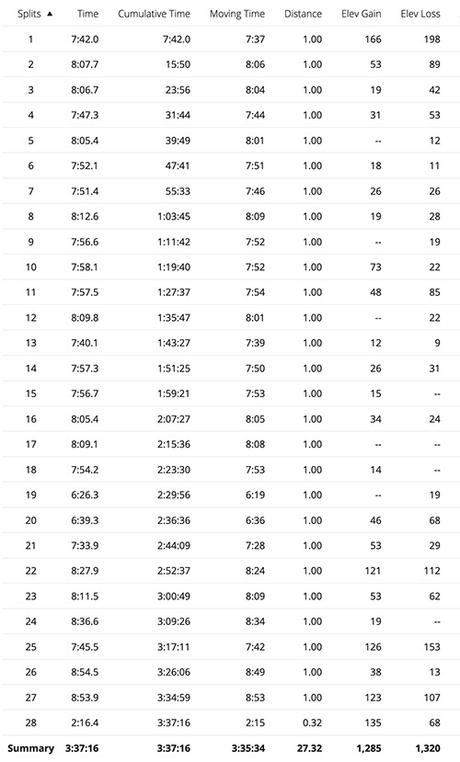Some people feel the rain. Others just get wet.
– Roger Miller
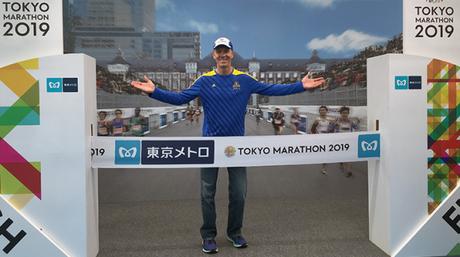
(Planning a trip to Tokyo? Check out my Tips for an excellent Tokyo experience at the end of this post.)
Cold, wet, and packed like sardines — the comparison felt appropriate given the steady drizzle and translucent, rain-slicked ponchos that lent many of my fellow runners a silvery sheen not unlike their oily marine counterparts.
This, I thought, gazing out over the vast sea of rain-soaked heads extending in each direction alongside the Tokyo Metropolitan Government Building, is awesome.
The rain continued to fall, my body quickly approaching saturation as the pre-race announcements from the PA system washed over me in Japanese. (Wait, was that a “Yokoso”? I think that means “Welcome.”) As if the wide-open heavens weren’t enough, sporadic gusts of wind shot like chilled daggers through the crowd as we stood shoulder to shoulder, collectively willing the starter’s pistol to fire.
Like shooting sardines in a barrel, Mother Nature must have been thinking.
Silently I glanced around at the restless, unsmiling faces in my vicinity. Worst people-watching ever, I thought with a smile. Despite the foul weather and my own lack of natural insulation, I was feeling great. And why not? This was the Tokyo freaking Marathon, a bucket-list race for runners across the globe. I was basking in the moment and primed to appreciate every step of the 26.2 miles from here to the finish line alongside the Imperial Palace.
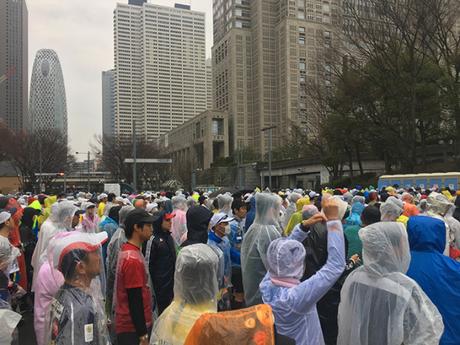
Waiting in the porta-potty queue with my fellow sardines
The sheer number of heads ahead of and behind me in the start corral — a seemingly endless flood of people — reminded me of the Comrades Marathon in South Africa, but on an even larger scale. Because whereas the world’s largest ultramarathon welcomes fewer than 20,000 starters, roughly double that number now waited for their cue to fill the streets of Japan’s capital city.
The logistics of the Tokyo Marathon start line contrast with other massive marathons such as Boston, Chicago and New York City, where runners are seeded into individual corrals based on speed, and start in one of several discrete “waves.” Faster runners start in the early waves and slower runners in the later waves, with each wave typically starting 15-30 minutes after the preceding wave to spread out the runners and limit overcrowding on the course.
Like its American brethren, Tokyo assigns each runner to a start corral based on recent and projected marathon finish times, with the corrals labeled alphabetically A–L (I’d be starting within view of the start line, in corral C). Unlike its US counterparts, however, the Tokyo start is one continuous wave rather than several smaller waves. Fortunately, the slick city streets would prove wide enough to accommodate 38,000 runners without excessive crowding.
All around us nondescript skyscrapers filled the bleak sky, their stark gray facades mirroring the weather if not the mood of the morning. My eyes flicked downward at my Garmin, tiny rivulets dripping from its own face. 9:05am. Hurry up and wait, I thought. Pre-race instructions had urged us to arrive in our corral by 8:45am for a 9:10am start, lest we be denied entry and shunted to the back of the pack. Glancing back again at the shapeless sea of bobbing heads stretching down the street, around the corner and out of sight, I shuddered at the thought of further prolonging this wait as much as at the persistent chill now gripping my body.
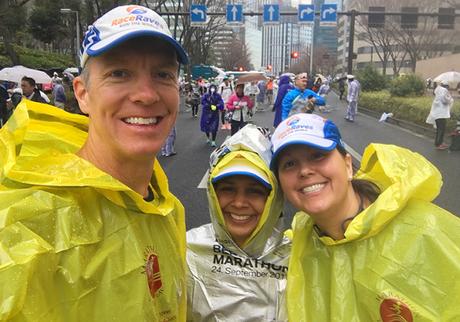
Shilpa, Louann and I couldn’t be happier to be standing in the rain
Unlike Boston or New York City (but much like Chicago), getting here on this Sunday morning had been relatively easy despite the weather. After a short walk from our host hotel the Hilton Tokyo, I’d kissed Katie goodbye and made my way past the security checkpoint, where I’d immediately encountered friendly faces in fellow Marathon Tours travelers Louann and Shilpa, likewise sporting disposable ponchos and headed toward their own corrals. One “before” selfie later, we’d wished each other well and parted ways, and I’d stopped to pack away my rain gear and check my drop bag.
Following posted signs toward bag check, I’d spied a curious sight I’d not seen since Berlin in 2014 — a separate Smoking Area where runners congregated for a last-minute charring of the lungs and hardening of the arteries in preparation to run 26.2 miles. And if that doesn’t convince you that nicotine is addictive, well…
I’d relinquished my drop bag and claimed my spot in — where else? — one of the lengthy queues for the porta-potties. A British fellow next to me in line wore short shorts and a fur-collared jacket, which I imagined to be getting heavier by the moment as the steady rain suffused it like a sponge. Impatiently I’d waited in line until finally I’d arrived at the front, only to be greeted by the announcement that the start corrals would be closing in five minutes. Yikes.
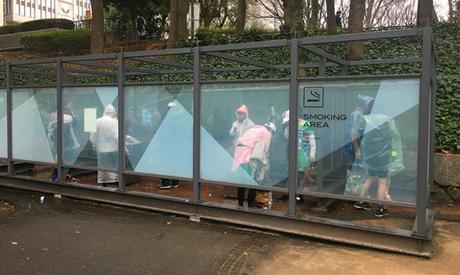
When running 26.2 miles is just too easy…
Faced with the specter of being the last runner to cross the start line, I’d been in and out of there like Superman in a phone booth. Fast-walking my way down the street toward my corral, I’d surveyed the scene of last-minute chaos, poncho-clad runners zigging and zagging across the street in all directions. I’d half-expected to feel a shadow engulf me and to find myself staring up at Godzilla’s massive clawed foot blotting out the sky.
Safely passing my checkpoint, I’d followed the frenetic stream of runners up a flight of concrete stairs to the street’s upper level, where a row of both Western- and Japanese-style porta-potties stood unoccupied. Dammit, shoulda waited. The desire to duck inside one of the plastic boxes even momentarily to escape the rain had been strong; instead, though, I’d joined my corral in front of the Tokyo Metropolitan Government Building where 38,000 runners (37,500 marathoners, 500 10Kers) now stood eagerly awaiting the last of the pre-race announcements.
At last the elite runners were introduced, followed a moment later by trails of smoke launched skyward alongside the start line. And with that, the first World Marathon Major of 2019 was underway.
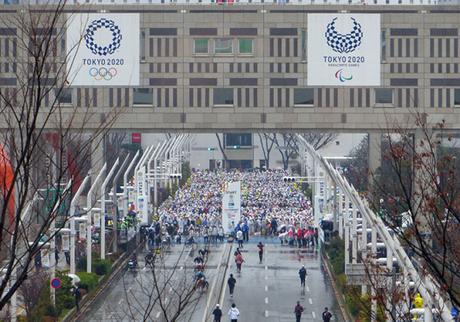
Awaiting the start of the 2019 Tokyo Marathon (view from the Hilton Tokyo)
Off and raining running
Established in 2007, Tokyo is the youngest member of the World Marathon Majors, a select group of six of the world’s most popular marathons that includes (in chronological order) Boston, London, Berlin, Chicago and New York City. The series was launched in 2006 with a mission to “advance the sport, raise awareness of its elite athletes, and increase the level of interest in elite racing among running enthusiasts.” Since then, the popularity of the series has continued to grow as amateur runners from around the world pursue the goal of completing all six marathons in the series to earn the coveted Six Star Finisher Medal. To date, 6,133 runners have earned this award, fewer than the number of summits of Mount Everest.
Aside from qualifying for Boston (the only marathon in the series which requires a qualifying time), one of the most challenging and frustrating aspects to completing the World Marathon Majors is accessibility. Tokyo and London are the most difficult marathons in the world to get into, and demand shows no signs of abating. For this year’s race alone, 330,271 Tokyo hopefuls submitted applications for fewer than 37,500 slots. And if you think those sound like tough odds, they’re downright favo(u)rable compared to London’s. This year 457,861 people submitted applications to run the 2020 London Marathon, a world record total that eclipsed the race’s own record number of 414,168 applications set just last year.
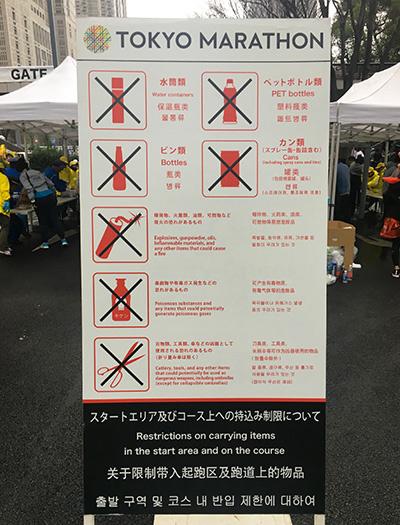
Restrictions a-plenty on what you can bring into the start corrals
Not surprisingly, the past several years have seen both the Tokyo and London lotteries treat me like Lucy’s football treats Charlie Brown. And so, with rejection emails piling up in my Inbox, this year I decided to secure a Tokyo entry the easy (if more expensive) way — through a tour operator, in this case Marathon Tours. With 40 years in the business and deep connections within the sport, Marathon Tours is the single largest third-party provider of official entries for both the Tokyo Marathon and London Marathon. This would be our fourth time traveling with the company internationally, having first joined them on our life-changing trip to Antarctica in 2013, during which their Seven Continents Club had inspired a new goal of running a marathon or ultramarathon on all seven continents.
Tokyo would earn a special high-five as my fifth World Marathon Major and (in the case of Asia) my fifth continent, with only Oceania and South America remaining. It would also be the first time I’d run in rain since… when? I couldn’t remember. I’d run in nasty heat on several occasions, but never in steady rain. So this would be another change of pace in an already memorable weekend.
And speaking of steady rain, here 6,700 miles away I’d witnessed first-hand the lingering effects of last year’s Boston Marathon, where icy rain and howling headwinds had left many runners battling hypothermia throughout the race. Faced with the harsh reality of another cold, wet and windy race day, the anticipatory looks on the faces of those who had suffered through Boston 2018 had been nothing short of PTSD.
Fortunately, “icy” and “howling” weren’t in the forecast for Tokyo.
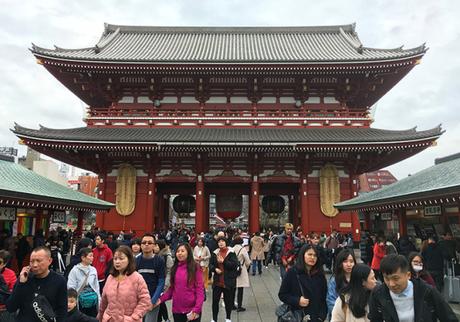
Sensoji Temple
In bleachers alongside the start line sat a number of happy faces — presumably marathon alumni of some sort — wearing green Tokyo Marathon shirts. Many of them smiled and waved as we crossed the start mat, our feet crunching on a slushy white substance underfoot. Was that snow?? I thought, before quickly deciding it was more likely salt or some similar substance to improve footing in the starting blocks.
Making our first right turn, I waved upward at the glass windows of the Hilton Tokyo many stories above, where Katie presumably sat watching the stampede start of the race before venturing out onto the course herself (she’d actually left moments before to try to catch me at the 10K mark). I ran comfortably — which usually means “too fast” — on the initial downhill, exercising caution and letting other runners pass me as I gauged the traction on the wet asphalt.
My goal for the day would be more ambitious than in recent marathons, but then again where better than Tokyo to get ambitious? I’d be targeting my fastest marathon in nearly two years, as I’d trained to run (in more favorable conditions) in the 3:30-3:35 range, meaning an average pace of 8:01-8:12/mile. In any case, I wanted to run well and start to regain some of the speed I’d lost to a slower 2018, a busy year of work and running which had included two 50+ milers at the Comrades Marathon and JFK 50 Mile.
Aiding me in my pursuit would be a brand-new pair of vermillion Nike Vaporfly 4% Flyknit shoes. Despite its terrible name, the 4% is the hottest new running shoe in recent years, having hit the market with the pricey promise of improving your running economy — if not necessarily your finish times — by an impressive 4%. (Notably, this claim gained credibility thanks to two third-party studies featured in The New York Times.)
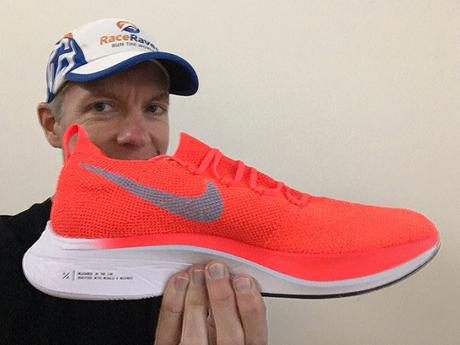
Originally designed for Nike’s Breaking2 project in May 2017, the shoe — along with considerable talent and support — propelled Kenya’s Eliud Kipchoge to within one second per mile (2:00:25) of the two-hour marathon mark at that unsanctioned event. Kipchoge would follow up that gem with another dramatic effort, crushing the world record in a time of 2:01:39 while wearing the shoe at the 2018 Berlin Marathon.
As a full-time running nerd and part-time shoe geek, I’d been intrigued by the 4% since it had first arrived on the scene with its curved, full-length carbon-fiber plate embedded in a layer of lightweight foam, a construction designed to act much like a spring underfoot, reducing energy usage while increasing propulsive forces. And yes, if you’re wondering how running on springs can be deemed legal by the sport’s governing bodies, you’re not alone. Which is why so many elite runners can be seen wearing the 4%.
Thanks to a generous Christmas gift from Katie’s parents, my fluorescent orange feet with the familiar gray swoosh now propelled me along the wet streets of Tokyo. Not knowing how much their lightweight springiness would be negated by the slick footing (based on reviews I’d read, traction isn’t their strong suit), I’d hesitated to wear them in the rain. In the end, though, I’d opted to give ‘em a go; certainly I wouldn’t be chasing a PR or BQ today, but dammit this was Tokyo, and we hadn’t crossed the Pacific Ocean so I could play this conservatively.
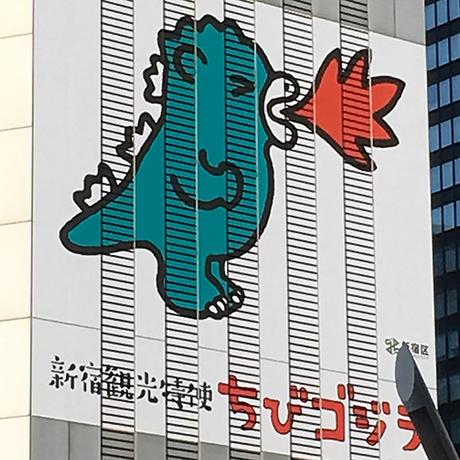
Breathing fire or spewing lunch? It all depends on your point-of-view
My Garmin struggled to find consistency amid the city’s soaring skyline. At one point in the opening mile my watch read a 6:45/mile pace, a number I knew to be a figment of its imagination. Luckily, the voice of experience had warned me to be ready for GPS issues, since tall buildings tend to block satellite signals. And in any case, I’m rarely a Garmin gazer; I generally prefer to run by feel and enjoy my surroundings rather than being a slave to my watch — which admittedly is one reason I run so many positive splits (i.e. second half slower than the first).
Looking at the downloaded data after the race, I was right not to trust my Garmin — whereas my total time was correct, total distance (27.3 miles), elevation (1,285 ft of gain??) and individual mile splits were all wonky, including a 6:26 mile 19 and 6:39 mile 20 that I only wish I could have credited to my new Nikes.
That said, the shoes felt good — comfortable, lightweight and bouncy. Having only run 6½ miles in them before this, and having never worn Nikes in a marathon before, my hope now was that they’d be kind to my feet for the full 26.2 miles.
Katie and I had visited this area two days earlier, and so at about the ¾-mile mark I knew to glance to my left and — sure enough, there was Tokyo’s favorite monster peering out over the top of the Shinjuku Toho Building at the end of the block, the one with the “Captain Marvel” movie poster taking up much of its façade. Godzilla!
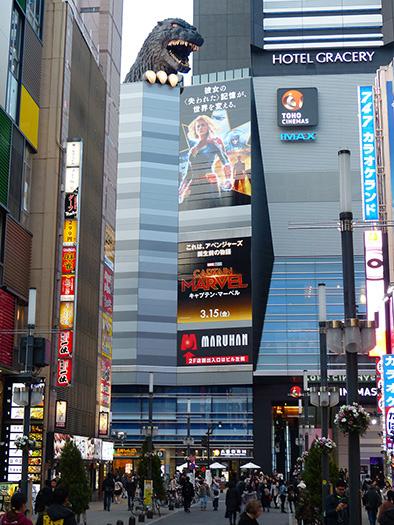
The King of the Monsters surveys his kingdom on Godzilla Road
Getting to know Tokyo
In fact, in our three short days here we’d already had a chance to visit some of the city’s most vibrant, quirky and photogenic neighborhoods. On Friday we’d joined our Marathon Tours group on a half-day driving tour of Tokyo. There we’d been reunited (and it felt so good 🎵) with Louann, one of our favorite people whom we’d met in Antarctica in 2013 and whom we’d seen most recently in Kansas City last year. Tokyo would be the final stop on her own incredible 12-year journey to run a marathon on all seven continents, and so Katie and I had devised a fun plan to help her celebrate, which we planned to unveil on race day…
One of the coolest things about traveling with a group like Marathon Tours is the opportunity to meet interesting, like-minded folks, and Tokyo would be no exception. Louann immediately introduced us to her travel buddy Shilpa, whom she’d first met at the Petra Marathon in Jordan, generally considered one of the world’s toughest marathons. Coming from Oklahoma City, Shilpa was looking forward to 2019 as a victory lap of sorts, with Tokyo being her 6th World Marathon Major followed by her 7th continent at the Gold Coast Marathon in Australia in July. She and Louann made an always entertaining pair, as they kept each other (and the rest of us) honest and amused.
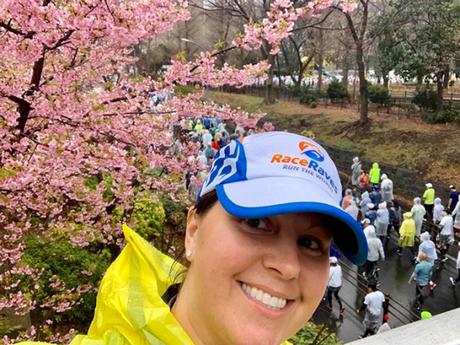
Louann is the type of person who can find cherry blossoms in the winter
Our Friday morning tour included a stop at Tokyo’s oldest temple, the colorful Sensoji Temple, where we learned Buddhist history and rituals as well as the proper Buddhist prayer stance. Inside the temple’s outer gate, a centuries-old street market sold a wide variety of Japanese snacks and souvenirs. The sights, sounds and smells of the bustling market all commingled, creating at once a sense of both indifference and intimacy that seemed to say, Welcome to Tokyo.
Fun fact: According to our local tour guide, sushi was invented in the 17th century by busy Japanese dock workers who needed to eat quickly so they could return to work.
Our second stop for the day would be a demonstration of Taiko drumming techniques, which although initially interesting (in part because we were able to participate), ended up feeling like an overly long group version of “Simon Says” in which we’d simply follow the lead of the head drummer, whose verbal descriptions were difficult to understand on the suboptimal sound system.
After lunch our group visited the race expo, which this year was held for the first time in an outdoor tent city located at the Odaiba-Aomi Event Area, across the Rainbow Bridge in Tokyo Bay. This change in venue had been necessitated by ongoing construction projects as the city prepares for the 2020 Summer Olympics. As it turns out, our timing was optimal — Friday afternoon’s dry weather was a marked improvement over Thursday’s rain, which had made life uncomfortable for expo visitors and exhibitors alike.
Packet pickup, which happened at the expo entrance, was amazingly efficient with the volunteer scanning my passport to verify my identity before securing a plastic bracelet around my wrist. And with that, I was street-legal and ready to run the Tokyo Marathon.
Entering the expo was like walking into a shopping mall, game show and video game rolled into one. I felt like a character out of Ready Player One. Voices, alarms, bells and whistles assailed my ears from all directions, many of them repeating themselves with unnerving regularity. Like high-pitched carnival barkers, young women played the role of enthusiastic hosts, attracting curious visitors who couldn’t resist the urge to stop and either watch or participate. Meanwhile, life-size Pokémon-style characters greeted visitors at several booths, hawking everything from tourism packages to athletic gear to cell phone plans. Even Pac-Man had his own booth and hey, who doesn’t love Pac-Man?
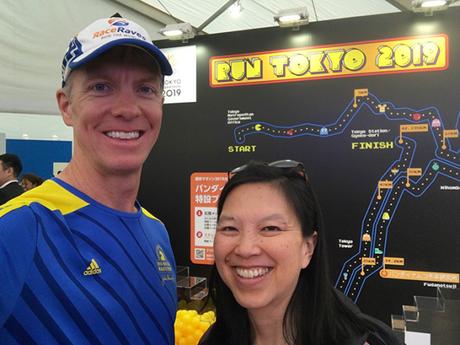
Now, racing through a steady drizzle that seemed in no hurry to abate, I was thankful for the one preemptive purchase I’d made at the expo — a pair of moisture-wicking gloves to keep my fingers warm in the event of… well, weather like this. Likewise, I was grateful for my RaceRaves cap which kept a steady stream of water out of my face. Overall, things were going swimmingly, pun intended.
That is, up until the 10km mark when, scanning the crowd in vain, I missed my first Katie sighting. Turns out she was trapped on the right (far) side of the street which, as luck would have it, happened to correspond to the 10km finish line. Trying to find her in a seemingly endless sea of raincoat-clad Asian faces would (luckily) be my only stressor of the day, as I quickly realized that the needle in the haystack analogy was maddeningly appropriate here in Tokyo.
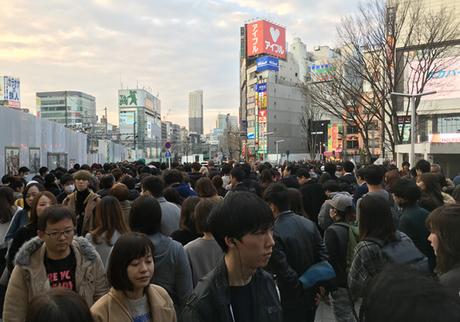
Just another Saturday on the streets of Tokyo
Jiāyóu! Jiāyóu!
My inability to read signage motivated me instead to focus on my fellow runners. At one point my attention settled on a woman running ahead of me who wore a shirt that read, in large letters on the back, “Mexico is the” with the last line covered by her running belt. My mind raced along with my body: “Mexico is the… Mexico is the what??” In the end, I lost track of her without learning what it was she wanted me to know about our southern neighbor. On an otherwise satisfying day, it was a wholly unsatisfying interaction.
Another fellow won my “least motivational message” award with his shirt that read, “Don’t finish last.” And why not? I thought. Unless you’re planning on going home with prize money, we’re all running this for the same medal. Besides, wouldn’t the final finisher enjoy a better dollar-per-minute value than the rest of us?
For better or worse, running 26.2 miles gives you plenty of time to think.
Besides its soaring buildings and life-size Godzilla head, Tokyo’s defining feature was its raucous crowds and high-energy community support. Even in the cold and rain, smiling faces and enthusiastic throngs greeted us at seemingly every turn, many of them wielding umbrellas against the elements. I’d not experienced crowd support like this since my last World Marathon Major in Boston in 2016, and I could only imagine what these streets might look like in more ideal weather.
The occasional “Go! Go! Go!” was the only English I could make out from the crowd, though happily I did recognize cries of “Jiāyóu! Jiāyóu!” (literally “Add fuel!”), an all-purpose Chinese cheer with which Katie’s Mom encourages me before each race.
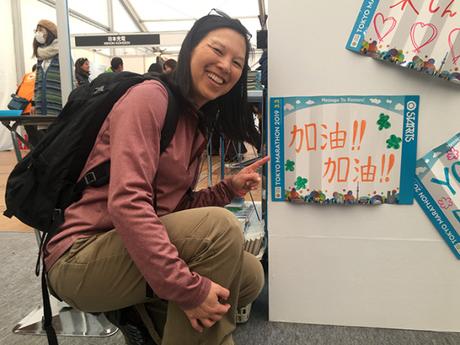
Jiāyóu!! Jiāyóu!!
Bands played, dancers performed, and at one point we were treated to a version of “YMCA” that had the runners ahead of me shaping their arms into each letter without breaking stride. And even 5,500 miles from home we couldn’t avoid the universally popular theme from “Rocky,” which I heard not once but twice along the course, the first time on a plaintive-sounding horn which made me think this must be the “rainy day” version.
Even with my eyes closed, though, I would have known I wasn’t running in the United States by the absence of Ozzy Osbourne’s “Crazy Train” along the course.
I’d be lying if I were to look at a map of the marathon course and rattle off a list of Tokyo landmarks, as though I remember seeing them along the way. With all signage in Japanese and the rain dulling my sense of our surroundings, few distinct highlights stuck with me. Two that did, though, waited in close succession at the route’s northernmost boundary in mile 10. There we passed the Thunder Gate (Karinarimon) to the Sensoji Temple we’d visited two days earlier. And turning to return the way we’d come, we were immediately greeted by a majestic if hazy view of the Tokyo Skytree, the tallest tower in the world and the second-tallest structure behind only the Burj Khalifa in Dubai.
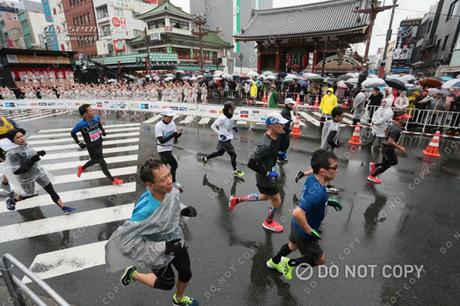
Running past the Sensoji Temple (background), mile 10
It was a memorable moment along what, for me as a Westerner, felt like a largely homogeneous urban course.
Near the halfway point the course opened up somewhat and would stay that way for the duration. With wider roads than Berlin, the route was never too crowded to be comfortably runnable. Though make no mistake, 38,000 runners never thin out too much.
Marathoners like to say that mile 18 or so is the real halfway point. Once I pass 13.1 miles, though, I feel like I can flip a mental switch and focus on running a solid half marathon. The key to the marathon is to stay mentally sharp, as I learned the hard way in Tucson in 2015. Once you clock out and lose that competitive edge, the finish line starts to feel increasingly far away.
Luckily I was feeling good, and why not? I’d slept well — actually, better than well; I’d slept great. Falling asleep immediately, I’d awakened 7½ hours later raring to go at 5:53am, seven minutes before my alarm. Unusual for race day, to say the least.
We interrupt this marathon race report for a snow monkey intermission:
For once, the toughest part of race morning hadn’t been getting out of bed; rather, in a uniquely Japanese twist, I’d had to coerce myself away from the electric toilet in our room, the one with the comfy heated seat and other options such as the privacy setting that introduces white noise while the user, um, takes care of business. I’ve yet to own a car with heated seats, much less a toilet. If I were a cat I would have curled up on that seat and gone to sleep, and especially on a day when a cold and steady drizzle awaited us outside.
Making a bold escape from our room, we’d joined the hotel breakfast buffet 12 hours after a full carbo-load session at the pre-race pasta dinner hosted by Marathon Tours. There our friend whom we’d first met at Comrades 2019, Coach and “Marathon Whisperer” Denise Sauriol from Chicago, had been the guest speaker.
(By the way, if you or someone you know is looking to run their first marathon, do yourself a favor and check out Denise’s excellent primer Me, You & 26.2. Yes, I read and enjoyed it despite being nine years removed from my first marathon — it’s that good, and so is she.)

At breakfast we’d checked in with Louann and Shilpa. There’d be no downplaying the significance of this day for both, and they were ready. Not taking any chances, Shilpa would be packing — in her case, potato chips along with tater tots smuggled out of the buffet as in-race salty snacks, plus a few yen to buy herself a Coke along the route. This was a woman who’d done this before (118 times before, but who’s counting?). Clearly, though, she wasn’t alone in her thinking — descending to the hotel lobby in an elevator full of runners, we’d overheard one woman confess to her friend, “I have a pantry around my waist.”
Occasionally along the out-and-backs, I’d glance over to look for familiar faces — Louann, or Shilpa, or maybe our speedy new friend Eric from Kansas City whom we’d met on Friday evening, when the five of us along with Eric’s friend Kenny had spent the evening out on the town, sampling the tasty menu at a standing sushi bar (where a friendly Japanese businessman had treated Louann and Shilpa), carbo-loading on dessert crepes, and people-watching at the iconic Shibuya Crossing intersection.
Unfortunately, with a steady stream of runners always coming in the opposite direction, I never saw a familiar face… though the thought of Shilpa leaving soggy potato chip crumbs in her wake like a modern-day Hansel and Gretel made me smile.
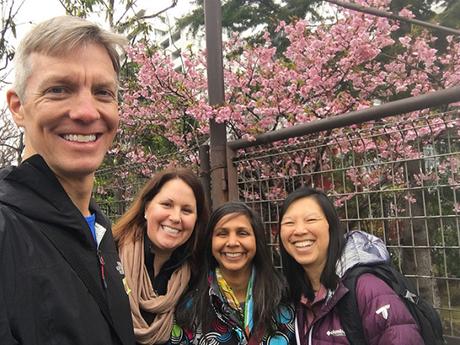
Here comes the rain again
The rain started, the rain stopped, the rain started, the rain stopped. After a while it became hard for me to tell whether it was in fact still raining. The reality to running in steady rain is that once you’re soaked, you’re soaked, and at that point you’re not getting any wetter. The silver lining on this day was that the rain never became heavier than a drizzle.
Volunteers stood every 50 yards or so along the course, holding trash bags to ensure that every discarded paper cup or empty gel packet found a happy home. Before, during and after the race, Tokyo’s streets were hands-down the cleanest of any city I’ve visited — a truth made more remarkable by the fact that Tokyo is also the largest city I’ve ever visited. I’ve never experienced an urban setting (and certainly not in the US) where trash bins were both unavailable and unnecessary.
As we ran, clear signs pointed down alleys along with a “Next bathroom: ___ km” message. I’d later hear complaints of long lines at porta-potties which were already a significant distance removed from the course, causing some back-of-the-pack runners to stress about making the official cutoff times. Luckily my own innards would behave well, and I was relieved not to have to relieve myself.
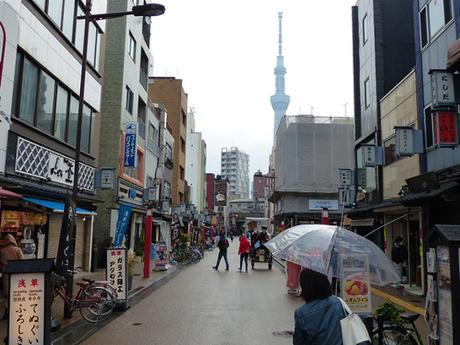
The Tokyo Skytree, seen from the Sensoji / Nakamise Market
Reaching the 27 km mark I began to scan the crowd as planned, until at last I heard Katie calling my name and saw her smiling face in a crowd of black raincoats around 28½ km. Quickly returning the smile, I thanked her and snatched a Maurten gel from her outstretched hand as I passed.
The gel was for insurance purposes rather than out of any immediate need, since I’d opted to carry only a single gel during the race. As in other marathons, my main concern here wouldn’t be nutrition but rather cumulative muscle fatigue in my legs — and all the gels in Japan weren’t going to change that.
I waited until the 32 km (mile 20) mark to down the gel; even at that late stage the calories had little effect. I never felt my energy levels dwindle, and in the cold rain I never felt thirsty. So I didn’t stop at aid stations, and I couldn’t tell you what the Pocari Sweat electrolyte drink served at those aid stations tastes like.
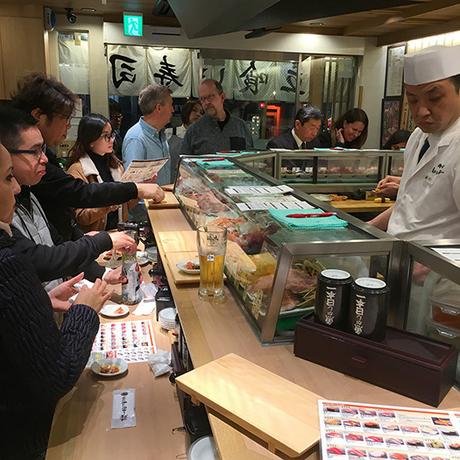
Not an aid station, but an excellent Standing Sushi Bar
Somehow “32 km” sounded less intimidating than “20 miles” (mind games, mind games), and with 10 km to go I resolved to bear down, focus on the ground a few steps ahead of me, and keep pushing along the final out-and-back. Despite the sense that I was still giving my all, I knew I was starting to slow — though I’d long ago given up on trusting my Garmin’s pace calculations.
Glancing to our left as we passed Shiba Park and the Zozoji Temple, the distinctive orange-and-white Tokyo Tower (Japan’s second-tallest structure) provided a splash of eye-catching color in an otherwise achromatic sky.
Approaching 35 km, a momentary pang of nausea chased away any thoughts I might have had of force-feeding myself a second gel.
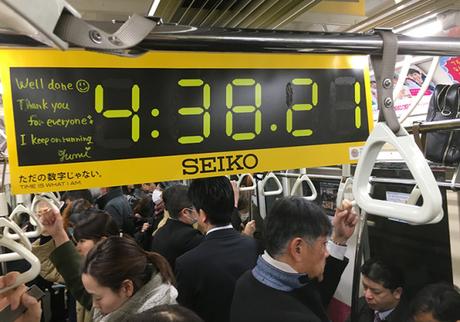
A cool touch: finisher times decorated Metro trains on Monday
Seeing a fellow with “# Run Your Own Race” printed on the back of his shirt, the only thought my marathon-muddled brain could formulate in the moment was a drunken, Hey waitaminnit, that hashtag won’t work AT ALL…
With around 6 km to go I began to notice nice, big signs counting down the distance remaining rather than counting up the distance already run, similar to the signage at Comrades. I’ve found this shrewd strategy to be a motivational pick-me-up near the end of races, and especially when the distance is in km since, well, they’re shorter than miles.
At 38 km I willed myself to dig deep as I wished for one more second (or third, or fourth) wind to carry me to the finish. In response, a stiff headwind rose up and blasted me in the face. Wrong wind! I thought bitterly as I put my head down and leaned in.
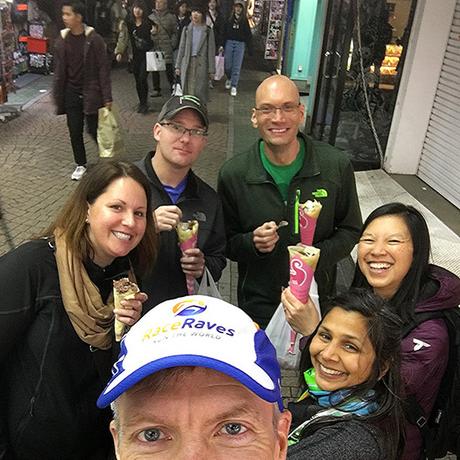
Crêpe-loading! (Clockwise from bottom: cameraman, Louann, Kenny, Eric, Katie, Shilpa)
Our final km of the day led us along the glistening stone surface of Marunouchi Naka-Dori Ave, a seemingly high-end retail district where bougie shops lined the street on either side of us. After 25 miles on asphalt, the potentially slick stones presented a new challenge, and I could feel my legs wobbling and my form disintegrating as I shortened my stride to gauge the footing. I wanted to finish strong, and so I tried to savor this final stretch while continuing to pound as hard as I could.
Hearing Katie’s shouts of encouragement was like divine intervention, and I knew at last that the glorious ending to another painful blog post marathon was near. Oh, what a feeling.
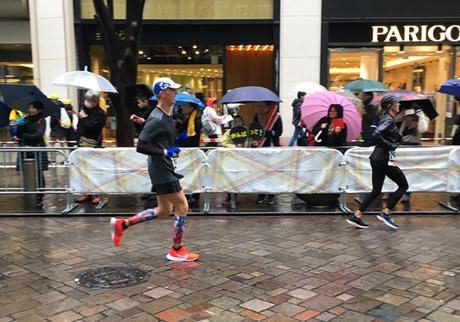
Hanging on in mile 26
With a final left turn and the sprawling red-brick Tokyo Railway Station at our backs, I emptied the tank with one last burst of energy and crossed the finish line all by myself…
… or so it seemed. Because despite this being one of the largest marathons on the planet, I felt in that moment as I crossed the blue mat that I was running solo, the finish line belonging to me and me alone. I’m not sure I’ve ever experienced such an ironic sense of solitude. And it drove home a universal truth — that even here among 37,499 other runners in a city of 13+ million, the marathon is at its core a solitary endeavor. You can’t reach the finish line without the support of many others, but success or failure as you define them are ultimately your own. And in an era when individuality feels increasingly hard to come by, isn’t that why we do this?
Looking back at the photos, I was genuinely surprised by the number of runners surrounding me at the finish. For one exhilarating moment time stood still…
… before the world sped up again, and I stopped the clock in an official time of 3:37:14, missing my 3:35 goal while still recording my fastest marathon in nearly two years.
Glancing down at my Garmin, I was momentarily confused by its message of “Fastest marathon!” and its perceived time of 3:27:xx. Then I realized it had registered a total distance of 27.3 miles, which by interpolation would indeed have put my marathon time in the 3:27 range. If only.
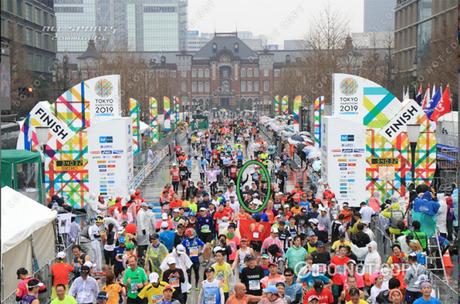
What the finish line actually looked like (that’s me circled in green)
A soggy mile 27
Moving unsteadily through the finish chute, I paused to collect my finisher’s medal, race-branded towel (not particularly useful in the rain), snack bag and heat sheet. To one side, newly minted Six Star Finishers claimed their well-deserved hardware at the Abbott booth. I congratulated my fellow finishers as we strolled, including one emotional woman from Iceland who’d just earned her own Six Star. If you think running six World Marathon Majors is challenging (and expensive) as an American, try doing it from Iceland.
Then I turned and breathed it all in, shivering as I watched the crowd of fatigued faces drift toward me, their bodies beaten and minds spent, chilled by the weather yet warmed by the journey. And ready to get the hell out of the rain.
And that’s when we discovered the worst thing about the Tokyo Marathon — the 27th mile. With my heat sheet wrapped tightly around me and the wind fighting to wrest it from my grasp, I reunited with Katie for the long, cold, wet, 25-minute stroll to the Tokyo International Forum, the post-race meeting area for friends and family. I know many runners objected to the absurd distance — hypothermia’s no joke — but with a high-octane cocktail of adrenaline and endorphins coursing through my bloodstream and warming me from within, I actually treated the long, slow walk as my personal victory lap.
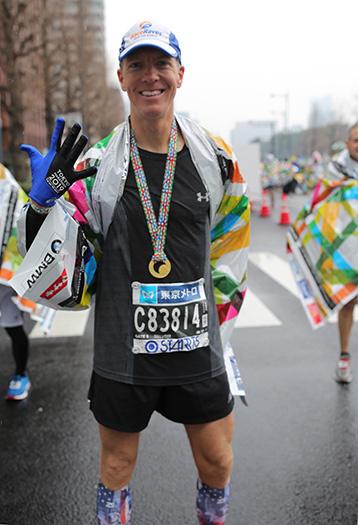
Tokyo = 5 continents & 5 World Marathon Majors
Reaching the International Forum at last, I happily changed into dry clothes in the men’s changing area, which included an acupuncture care area and foot-soaking stations. Then Katie and I compared notes while we waited for Shilpa, who would be the next of our group to finish.
She entered the building sometime later looking like a drowned rat, exhausted but triumphant with her Six Star Medal but with no dry change of clothes. I gave her my Boston Marathon jacket to wear and pointed her toward the hotel shuttles so she could get back and warm up. The road to the Six Star is costly enough without tacking on a hospital bill for pneumonia.
Then Katie and I left the comfort of the International Forum and headed back out into the rain. Because our day was not yet done, and one of the best parts was still to come…
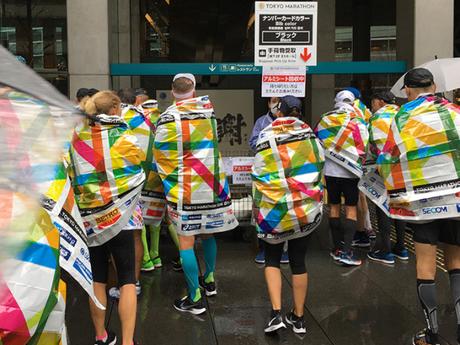
Hypothermic technicolor zombies
Six Stars and Seven Continents
Completing a marathon on all seven continents is a long and arduous undertaking, and so it’s important to embrace both the journey and the destination. Louann had certainly done that — after all, embracing life in all its possibilities is how she rolls. And having first met her in Antarctica in 2013 midway through her own seven continents quest, we now wanted to help her celebrate its finale in a fun and fitting way. Though the truth is, nothing short of a Disney-style electrical parade feels sufficient to recognize such an epic achievement.
With that in mind, we’d created and brought with us to Tokyo a custom “Cheerleader Louann on a stick,” i.e. an oversized cutout of her face, mounted on a wooden rod and adorned with its own blue ribbon and paper Seven Continents Club finisher medal. Like the trooper she is, Katie had carried Cheerleader Louann — wrapped in plastic to protect her from the rain — with her throughout the day, though unfortunately she’d missed seeing the real Louann out on the course.
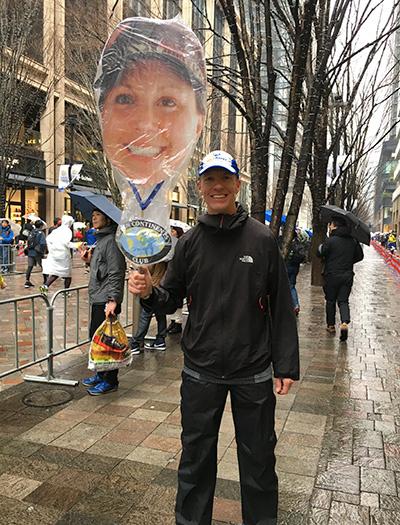
With Cheerleader Louann at mile 26
Walking a straight line from the International Forum to the course (a much shorter distance than the walk from the finish line), we arrived on Marunouchi Naka-Dori Ave and planted ourselves between the 41 km and 42 km markers. There we waited, scanning the oncoming crowd as we cheered and encouraged soggy runners. Some glanced over at us with dull eyes, their minds and bodies on the brink of exhaustion as hypothermia nipped at their heels. Arms pumped furiously, presumably trying to offset the loss of momentum in depleted legs.
Soon we saw Louann approaching, eyes cast downward and still smartly sporting her disposable poncho. She glanced up in response to our shouts and cheers, and the look that flashed across her face as she locked eyes with — well, herself — was priceless. Nothing captures the sheer elation, pride, appreciation, and even relief at a 12-year journey successful concluded quite like Louann’s reaction in that moment. And I like to think the last-minute surge of adrenaline was just the oomph she needed to propel her to a sub-6-hour finish.
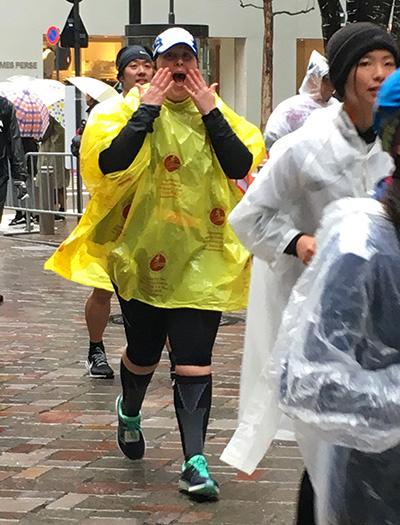
Louann spies her (literally) biggest supporter
Congrats Louann! As our mutual friend Rory would say, love your work. So happy we could be there to witness and share in your awesome accomplishment first-hand.
That evening we attended the Marathon Tours post-race party, held in The Ballroom on the 39th floor of the Park Hyatt, the hotel where “Lost in Translation” was filmed. As post-race parties go, this was easily the best I’ve attended, with a wide assortment of hors d’oeuvres and drinks to pep up even the most exhausted runner.
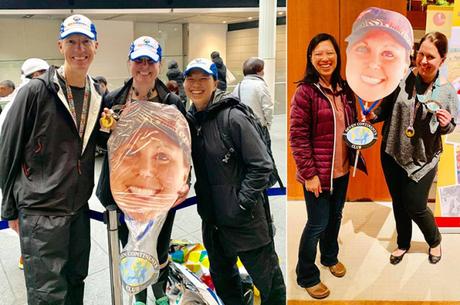
And both Louanns clean up beautifully, too!
Jeff Adams, the President of Marathon Tours, said a few words of welcome and congrats. Then he called up Louann and another Seven Continents Club (SCC) finisher to recognize their achievement, though admittedly the finisher’s medal he hung around their necks was significantly smaller than the one modeled by Cheerleader-Louann-on-a-stick. Nonetheless, with fewer than 800 SCC marathon finishers in the world, theirs is a feat that makes summiting Everest look like a paint-by-numbers exercise.
Next the group acknowledged over 100 new Six Star Finishers, including Shilpa and our new buddy Eric. Tom Grilk, the CEO of the Boston Athletic Association, said a few words of congratulations, as did the fellow in charge of the Six Star initiative at Abbott. It was a fitting ending to a terrific weekend. Though when Jeff mentioned the possibility of Singapore as the 7th World Marathon Major, skeptical groans arose from the room… and did I see a couple of finishers grip their new medals just a bit more tightly? Clearly six stars is plenty for most folks.
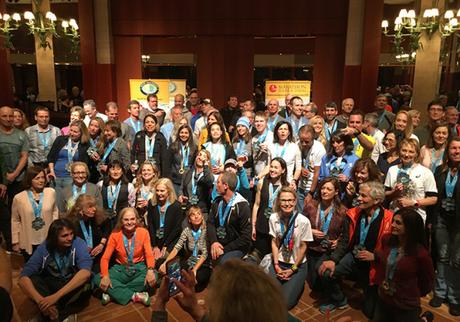
Six Star Finishers at the Marathon Tours post-race party
With 119 marathon finishes to her name, including all 50 states and six World Marathon Majors, Shilpa has her sights set on completing her 7th continent at the Gold Coast Marathon in Australia this July. After which she claims she’s done with marathons. Quite a résumé for someone who professes not to enjoy running.
And since you can’t spell Tokyo without “Kyoto” (or vice versa), on Monday we bid sayonara to Tokyo and boarded the bullet train to Japan’s former capital city. With 1.5 million residents, Kyoto felt more manageable and less intimidating than Tokyo, and the city is what most Westerners think of when they think of Japan — ancient Buddhist temples, colorful Shinto shrines, serene Zen gardens, women clad in elaborate kimonos. We even caught the start of cherry blossom season and scored an audience with an entertaining troop of Japanese snow monkeys (macaques).
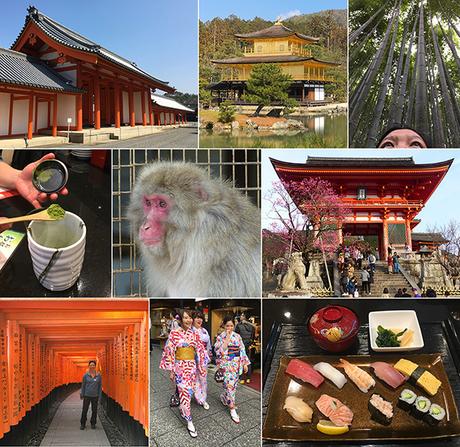
Scenes from Kyoto (clockwise from top left): Imperial Palace; Kinkakuji (Golden Pavilion); Arashiyama Bamboo Forest; Fushimi Inari-taisha Shrine to the god of rice and sake; dinner is served; kimono-clad women; a few of the 10,000 torii (gates) which line the walkways of Fushimi Inari-taisha; Uji Matcha, a Kyoto specialty; pensive snow monkey (macaque)
And with that, we closed the book on Japan and World Marathon Major #5, with only London remaining. But not before Tokyo had left its mark on my heart and on my psyche, and had made clear why it hosts a World Marathon Major. It’s a vibrant, soaring, imposing, boisterous, exhilarating city. It buzzes with pressurized neon and crackles with human electricity. It’s distinctly cosmopolitan yet decidedly traditional, serious-minded yet unabashedly whimsical. It’s a palette of infinite color on a backdrop of functional gray. Tokyo is New York City on Red Bull. It’s a global city unlike any other. And as a country, the United States could learn a lot from the Japanese about cleanliness, respectfulness, civic pride, and a comfortable toilet experience.
Upon exiting the changing room in the International Forum, we’d been greeted by exuberant, yellow-jacketed volunteers who had formed a congratulatory chute, applauding and high-fiving appreciative marathon finishers as we passed. A smile spread across my tired face. One volunteer held a sign that read, “Congratulations! Tokyo loves you.”
Arigato gozaimashita, Tokyo. The feeling is mutual.
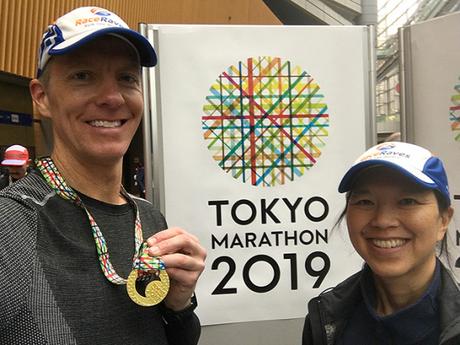
Tips for running in the rain:
- Once you’re wet, you’re wet, and so as long as you’re dressed appropriately and generating enough body heat to avoid hypothermia, don’t let Mother Nature throw you off your game.
- Avoid stepping on metal manhole covers, bridge expansion seams, painted lines, or other potentially slick surfaces.
- Wear a hat with a brim to keep the rain out of your face — this makes a huge difference and especially over the course of 26.2 miles. I recommend a comfortable and stylish RaceRaves running hat!
- Apply an anti-chafing salve liberally to any region of the body that stands even the slightly chance of chafing. If you think you chafe badly on a dry day, you ain’t seen (or felt) nothing ‘til you’ve chafed in the rain.
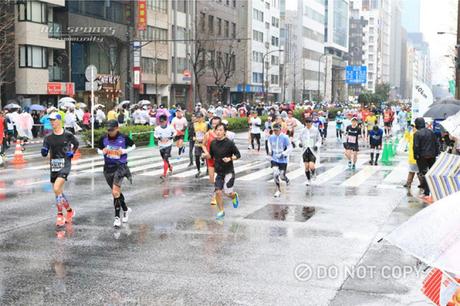
Tips for an excellent Tokyo experience:
- Tokyo is an amazingly clean city with highly respectful residents, so don’t be freaked out by anyone wearing a hospital-style face mask. The air in Tokyo is perfectly breathable, and so some folks will wear a mask to avoid allergens or, if they have a sniffle, as a courtesy to others to prevent the spread of germs.
- The Metro/Subway and JR (Japan Railways) transit systems are much more intuitive to use than their maps — which resemble a plate of rainbow spaghetti — would suggest, since they smartly use colors, numbers and symbols as well as words to indicate routes and directionality. With that in mind, I wouldn’t waste your time trying to figure it out from afar before you get here. The easiest way to ride the Metro and JR commuter trains (which operate on separate lines) is with a prepaid PASMO card that you can easily buy when you arrive. Train stations do tend to be much larger than their American counterparts, so build in time to navigate their maze-like corridors. Here’s a helpful article on the Tokyo train and subway system.
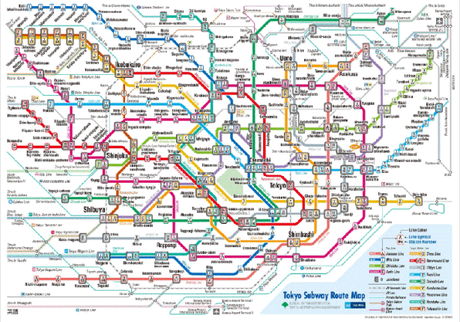
- The bullet train from Tokyo to Kyoto (and other cities in Japan) is a sweet ride, and on a clear day you can glimpse Mt. Fuji in the distance from your train car.
- Cabs in Tokyo are super-expensive; we made that mistake once.
- Japanese fluency is helpful but not essential when dining out; many restaurants feature an English menu, and most waiters/waitresses know enough English to get by. As pescatarians, we had little trouble avoiding the abundance of meat. Trying to locate a specific restaurant based on map directions, however, could end up being an adventure.
- Speaking of food, even if you’re not typically a fan of sushi, you have to try it in Japan (when in Rome…). I’m not a seafood lover myself, but the difference between Japanese and most American sushi was striking even to my unrefined palate.
- The Google Translate app does a very rough job of translating Japanese to English for both text and photos.
- Tokyo is an expensive city in many ways; at the same time, there are plenty of opportunities to eat well at reasonable prices, and especially if you like ramen or soba noodles. Not surprisingly, some of the ramen is incredible — in particular, one noodle dish that was recommended to us and which I’m now recommending to you is abura soba, which uses oil instead of broth to lightly coat the noodles. Simple but brilliant.
- Vending machine selections are color-coded to indicate hot (red) and cold (blue) drinks.
- Credit cards are widely accepted, so don’t feel like you need to carry much cash.
- Spoiler alert: Tokyo is a big city and, as in other big cities, it can feel like it takes at least 30 minutes to get anywhere. Plan accordingly.
- Those bumpy surfaces found on sidewalks, crosswalks, and transit boarding platforms in subway and train stations? They’re actually tactile paving (or “Tenji blocks”) developed by inventor Seiichi Miyake in the 1960s to assist the visually impaired.
- Unlike the United States where tip jars are now ubiquitous, gratuities are neither expected nor, in some cases, accepted in Tokyo. And boy, is it nice.
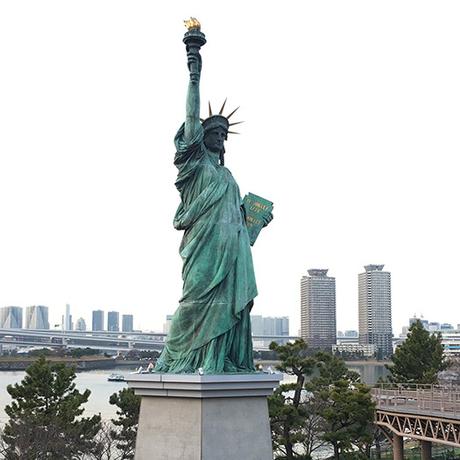
Tokyo’s replica Statue of Liberty stands ~13% the height of its US counterpart
BOTTOM LINE: Tokyo is big, it’s bold, it’s bonkers. It’s eclectic, electric, hypnotic, frenetic. And it’s a heck of a place to run a marathon. As the most populated metropolitan area in the world, Tokyo feels like New York City — on steroids. Coming from Los Angeles, I felt strangely at ease with Tokyo’s vast urban sprawl, which others may find unsettling (though if you’re only in town for the marathon, you may not experience it). And speaking of unsettling, the city is remarkably clean — never would I have expected to find myself in an urban setting of 13+ million residents where trash bins are both unavailable and unnecessary.
If you’re an American planning to run the Tokyo Marathon, odds are you’re doing so in your quest to run all six World Marathon Majors (Tokyo, Boston, London, Chicago, Berlin, NYC) and earn the coveted Six Star Finisher Medal. Either that or you love banging your head against the wall, because Tokyo (along with London) is the most difficult marathon in the world to get into; last year alone, the race received 330,271 applications for fewer than 37,500 slots.
With that in mind, if you’re determined to run Tokyo then your best bet is either to run for one of the race’s approved charities or to travel, as we did, with a tour operator like Marathon Tours — though be aware that given the high demand, Marathon Tours conducts its own mini-lottery to distribute its available Tokyo and London entries. And though you will pay a premium through Marathon Tours (this is their business, after all), it’s unlikely to be a deal-breaker for runners with Six Star fever on the brain.
Plus, the company hosts a Friday city tour and pre-race pasta buffet, as well as a terrific post-race party replete with drinks and hors d’oeuvres, the latter held in the swanky 39th floor ballroom of the Park Hyatt, the hotel where the movie “Lost in Translation” was filmed. (Apparently the Park Hyatt was also destroyed by a UFO in the movie “Godzilla 2000,” but hey you can’t win ‘em all.) As part of the post-race festivities, two Seven Continents Club finishers (including our friend and fellow Antarctica adventurer Louann) as well as over 100 Six Star Finishers were recognized. It was a unique opportunity to meet fellow traveling runners, and the perfect ending to an amazing day.

Rainbow Bridge across Tokyo Bay
As for the race itself, Tokyo is quite possibly the most high-energy marathon you’ll ever run (I can’t speak for London yet, though apparently it holds its own). It’s a sporting event on a global scale, hosted by folks who know how to throw a party. Even in the cold and rain, the streets of Tokyo were lined with spectators and supporters holding signs and cheering loudly. If you’re the type of runner who’s motivated by community support, Tokyo will inspire you from start to finish. And being able to see fellow runners coming from the opposite direction on the out-and-backs was a nice distraction, as I scanned the soggy crowd for familiar faces. One word of warning: the combination of soaring skyscrapers and frequent turns may cause your GPS to betray you at times (mine claimed a final distance of 27.3 miles, along with a 6:26 mile 19 and 6:39 mile 20 that I’m confident I didn’t run).
Like the other World Marathon Majors, Tokyo is decidedly unique in the way it carries and presents itself. It’s the very definition of a well-oiled machine, professional and buttoned-up without sacrificing its luster and charm. After the race we were greeted back at the Tokyo International Forum by smiling volunteers holding signs that read “Congratulations! Tokyo loves you.” And the feeling was mutual.
No scene epitomizes Tokyo like the iconic Shibuya Crossing intersection:
PRODUCTION: Tokyo Marathon 2019 production can best be described in terms of pre- and post-finish. From the start line alongside the Tokyo Metropolitan Government Building to the finish line on the grounds of the Imperial Palace, race day production didn’t miss a step or skip a beat. Similar to Chicago but unlike Boston and New York City, the start corrals were easily accessible and within walking distance of the host hotels. And volunteers posted every 50 yards or so along the course held trash bags to ensure that every scrap of trash found its happy home.
To be able to organize and mobilize 38,000 runners (including 500 10K runners) from around the world through the streets of a densely packed city like Tokyo without incident is an extraordinary accomplishment, one for which the organizers deserve huge props.
The only downside to race day (aside from the challenge of finding Katie amid throngs of raincoat-clad Asian people) was the long walk from the finish line to the Tokyo International Forum building, where friends and family waited for finishers. Fortunately I was wearing gloves and wrapped in a heat sheet; nonetheless the 30-minute walk in the cold drizzle was a bizarre end to such an impeccably organized event. But in the words of every pro athlete who’s ever been interviewed, it is what it is — and honestly I was too busy basking in my post-race high to focus on much of anything else, which made the lengthy stroll feel more like a slow victory lap.
As far as nutrition goes, with the weather virtually eliminating my thirst I didn’t take advantage of the plentiful aid stations, so I couldn’t tell you what Pocari Sweat (the on-course electrolyte drink of choice) tastes like — no reason to try something new on race day if I didn’t need it. And understandably given the sheer size of the race, post-race food was limited to a bag of munchies, the best of which was an odd custard-like peanut-butter sandwich which most runners seemed to agree hit the spot. That, and I always bring my own supply of Tailwind Rebuild for after the race.
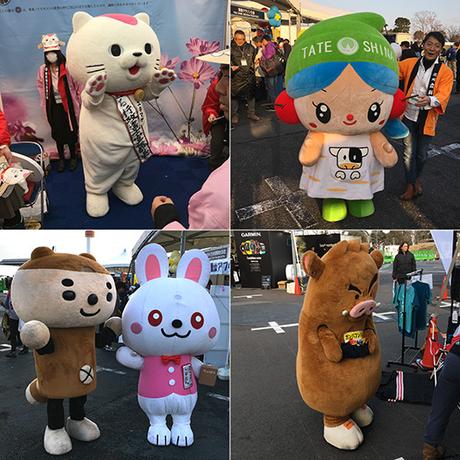
Some of the locals you might meet at the expo
The pre-race expo was unlike any I’ve experienced in the US or abroad. Strolling the expo was like stepping into a game show/video game, with high-pitched voices, alarms, bells and whistles assailing the ears from all directions. If you’re generally not a fan of busy expos or high volume, you may not appreciate the Tokyo expo; admittedly, though, I found it oddly fascinating and difficult to leave. Luckily, few of the booths were of real relevance to me (in part because, well, language barriers), though we did visit our friends from INKnBURN whose headquarters is located near us in SoCal. Due to ongoing construction as the city prepares for the 2020 Summer Olympics, this year’s expo was held in a new outdoor venue, a tent city set up at the Odaiba-Aomi Event Area, across the Rainbow Bridge and about an hour subway ride from the marathon start line in Shinjuku City. Whether the expo will return to this same venue in 2020 is unclear.
One note of warning: I’m not much of an expo shopper myself, but I heard several folks say the official marathon jacket sold out quickly, so if that’s your angle you’ll want to hit the expo on Thursday to beat the crowds.
Not surprisingly, Tokyo’s race photos were expensive — in fact, the most expensive of any of my 40 marathons to date. Even so, $39 per picture or $195 USD (21,600 yen) for the entire set felt like highway robbery. So if you have your heart set on buying professional photos of your Tokyo Marathon experience, be sure to factor that cost into your budget.

SWAG: Much like the other World Marathon Majors, Tokyo swag for me was all about the finisher medal, which is colorful and distinctive. On the other hand, I’ve yet to remove the short-sleeve white race tee from its plastic wrapper, since having seen it on others I know I’m unlikely to wear it. Cooler than the tee, though, is the full-size towel emblazoned with the race design and logo that we received at the finish line and which will come in handy.
In the end, completing the Tokyo Marathon is not only an awesome experience and a humbling achievement; it’s also one step closer to the ultimate prize of the Abbott Six Star Finisher medal. Five down, London to go!
RaceRaves rating:
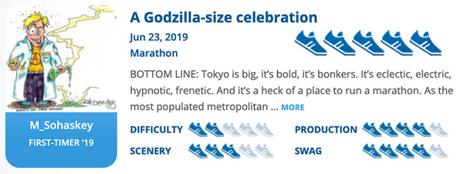
FINAL STATS:
(distance and elevation change may be inaccurate due to tall buildings)
Mar 3, 2019 (start time 9:10 am)
27.32 miles in Tokyo, Japan (continent 5 of 7)
Finish time & pace: 3:37:14 (first time running the Tokyo Marathon), 8:17/mile (assuming 26.2 miles)
Finish place: 6,068 overall, 1,182/6,328 in 40-49 age group (men & women)
Number of finishers: 35,440 (27,238 men, 8,202 women)
Nationality place: 232/1,039 (USA)
Race weather: cold (43°F), rainy & windy at the start & finish
Elevation change (Garmin Connect): 1,285 ft gain, 1,320 ft loss
Elevation min, max: 0 ft, 254 ft
